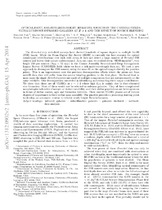| dc.contributor.author | Dave, Romeel | |
| dc.contributor.author | Yan, Haojing | |
| dc.contributor.author | Stefanon, Mauro | |
| dc.date.accessioned | 2016-10-12T15:07:47Z | |
| dc.date.available | 2016-10-12T15:07:47Z | |
| dc.date.issued | 2014 | |
| dc.identifier.citation | Yan, H. et al. (2014). Optical-faint, far-infrared-bright Herschel sources in the CANDELS fields: Ultra-luminous infrared galaxies at z > 1 and the effect of source blending. The Astrophysical Journal Supplement Series, 213(1) | |
| dc.identifier.issn | 0004-637X | |
| dc.identifier.uri | http://hdl.handle.net/10566/2448 | |
| dc.identifier.uri | http://dx.doi.org/10.1088/0067-0049/213/1/2 | |
| dc.description.abstract | The Herschel very wide-field surveys have charted hundreds of square degrees in multiple far-IR
(FIR) bands. While the Sloan Digital Sky Survey (SDSS) is currently the best resource for optical
counterpart identifications over such wide areas, it does not detect a large number of Herschel FIR
sources and leaves their nature undetermined. As a test case, we studied seven ''SDSS-invisible'', very
bright 250 m sources (S250 > 55 mJy) in the Cosmic Assembly Near-infrared Deep Extragalactic
Legacy Survey (CANDELS) fields where we have a rich multi-wavelength data set. We took a new
approach to decompose the FIR sources, using the near-IR or the optical images directly for position
priors. This is an improvement over the previous decomposition efforts where the priors are from
mid-IR data that still suffer from the source blending problem in the first place. We found that in
most cases the single Herschel sources are made of multiple components that are not necessarily at the
same redshifts. Our decomposition succeeded in identifying and extracting their major contributors.
We show that these are all ULIRGs at z 1 - 2 whose high LIR is mainly due to dust-obscured
star formation. Most of them would not be selected as sub-mm galaxies. They all have complicated
morphologies indicative of merger or violent instability, and their stellar populations are heterogeneous
in terms of stellar masses, ages and formation histories. Their current ULIRG phases are of various
degrees of importance in their stellar mass assembly. Our practice provides a promising starting point
to develop an automatic routine to reliably study bright Herschel sources. | en_US |
| dc.language.iso | en | en_US |
| dc.publisher | American Astronomical Society | |
| dc.rights | This is the author version of the article available online at: http://dx.doi.org/10.1088/0067-0049/213/1/2 | |
| dc.source.uri | http://dx.doi.org/10.1088/0067-0049/213/1/2 | |
| dc.subject | Submillimeter galaxies | en_US |
| dc.subject | Galaxies | en_US |
| dc.subject | Astronomy | en_US |
| dc.subject | Infrared galaxies | en_US |
| dc.subject | Cosmic Assembly Near-infrared Deep Extragalactic Legacy Survey (CANDELS) | |
| dc.subject | Sloan Digital Sky Survey (SDSS) | |
| dc.title | Optical-faint, far-infrared-bright Herschel sources in the CANDELS fields: Ultra-luminous infrared galaxies at z > 1 and the effect of source blending | en_US |
| dc.type | Article | en_US |
| dc.privacy.showsubmitter | FALSE | |
| dc.status.ispeerreviewed | TRUE | |
| dc.description.accreditation | ISI | en_US |

